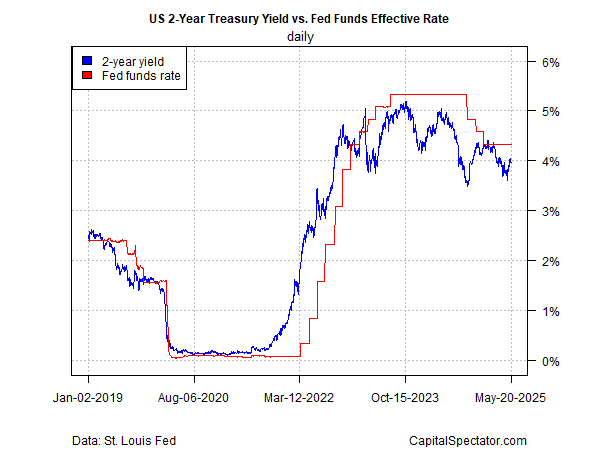Here’s why Citi says crypto prices have been weak recently
Uncertainty about inflation, the economy, and trade policy continues to blur the macro outlook, which in turn supports expectations that the Federal Reserve will leave interest rates unchanged at the next several policy meetings.
Fed funds futures are pricing in a near-certain probability that the central bank will let its current 4.25%-4.50% target rate stand at the upcoming June 18 FOMC meeting. The bets are skewed in favor of standing pat at the July meeting too. The guesswork tilts to predicting a cut in September, although the implied probability is a moderate 65% at the moment.
Meanwhile, the US Treasury market seems to be anticipating an earlier rate cut. The policy-sensitive 2-year yield continues to trade well below the current Fed funds rate, which suggests that the crowd expects policy easing sooner rather than later.

The one aspect that’s probably a consensus view is that elevated uncertainty weights on projections for the macro trend in the near term. St. Louis Federal Reserve Bank president Alberto Musalem on Monday highlighted the ambiguity, which is keeping the central bank in a wait-and-see mode:
“To the extent that the economy requires capital expenditure to continue to occur, that it requires hiring to continue to occur, and if all those decisions have been somewhat paused because of the uncertainty, it would affect the economic outlook I would expect. I don’t want to give a precise number estimate, but I would say it tends to be a pretty meaningful impact.”
A complicating factor is the federal government’s growing pile of debate. The bond market is increasingly focused on the US fiscal deficit, along with the possibility that the red ink could increase if Congress passes the budget legislation currently under review in the House.
“We have expected a narrative shift could take place from positive tariff news to negative budget/fiscal issues, which can see another round of ‘sell the US’: higher back-end yields [or long-term interest rates], lower risk assets, and lower US dollar,” Citi analyst Daniel Tobon wrote in a note to clients on Monday.
Fiscal risk came into sharper focus after Moody’s downgraded the US credit rating on Friday. The stakes, it seems, are rising for Congress to address the deficit. At the moment, however, the political will to reign in spending appears weak. As the Financial Times reports:
“The non-partisan Committee for a Responsible Federal Budget estimates the legislation would increase the public debt by at least $3.3 trillion through to the end of 2034. It would also increase the debt-to-GDP ratio from 100% today to a record 125%, the group said. That would exceed the rise to 117 per cent projected over that period under current law. Meanwhile, annual deficits would rise to 6.9% of GDP from about 6.4% in 2024.”
The House has yet to finalize a bill, but recent drafts that have been made public point to higher deficits in the years ahead – a trend that’s prompted criticism from various corners.
“It’s time for policymakers to hit pause, go back to the drawing board and put forward a plan that actually takes steps toward putting our nation on a sustainable fiscal trajectory,” said Maya MacGuineas, president of the Committee for a Responsible Federal Budget, a public policy think tank. “Our federal interest payments are skyrocketing, already surpassing what we spend annually on defense or Medicare.”
The Trump administration counters that the bill under consideration in the House “does not add to the deficit,” according to White House spokeswoman Karoline Leavitt in a press conference on Monday. “In fact, according to the Council of Economic Advisers, there’s $1.6 trillion worth of savings in this bill — that’s the largest saving for any legislation that has ever passed Capitol Hill in our nation’s history.”
The final arbiter will likely be the bond market. In particular, watch the 10-year Treasury yield, which can be used as a proxy for sentiment on fiscal risk. At the moment, the benchmark rate is 4.49%, moderately below the January high of roughly 4.80%. To the extent this key rate moves closer to 5%, it’s reasonable to assume that the market is losing faith in the US government’s ability to control its spendthrift ways.
